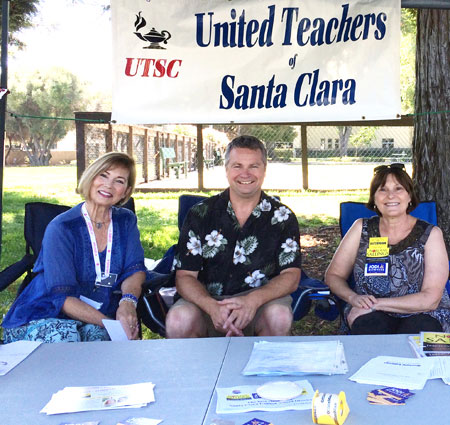
Michael Hickey is a former teacher at Scott Lane and Briarwood elementary schools. An East San Jose native who is bilingual in English and Spanish, Hickey lends his knowledge to other fellow educators as president of United Teachers of Santa Clara. The union is affiliated with California Teachers Association (CTA) and the National Education Association (NEA).
“The United Teachers of Santa Clara represents the certificated personnel of the Santa Clara Unified School District,” Hickey says. “We have around 800 members. We are mostly teachers, but we also include psychologists, counselors, nurses, speech pathologists and other educators. Our mission is to advocate for public education and for the students that are served by the Santa Clara Unified School District.”
Hickey says that his union’s current contract with the school district is founded on ensuring that certificated personnel have the resources they need to meet the needs of the students.
“For example, we have limits on how many students can be in a classroom,” Hickey says. “Another example is, we need to ensure that teachers have adequate access to technology and other resources to meet student needs. Also, teachers spend many hours outside their class time preparing for lessons, and so our contract provides a limited amount of time during school days that will allow teachers to prepare for classes.”
Acknowledging that teacher unions frequently come under fire in the media, Hickey wants to set the record straight about why these unions are relevant.
“We’re not defending bad teachers; we are defending due process,” Hickey says. “It is essential that teachers have the power to advocate for students. And oftentimes that means disagreeing with administrative directives. For example, I had a situation where I was asked not to speak Spanish to students who came from a Spanish-speaking background. I refused. That’s an example of when teachers need to have the ability to advocate for what is right for their students without fear of retribution.
“There is [also] a myth perpetuated that unions are self-serving, particularly with teachers’ unions,” Hickey continues. “The CTA advocates for working conditions that are adequate to meet the needs of our students, and obviously, we also work to get adequate compensation so our members can live in Silicon Valley.” The impact teachers have on students is indisputable.
Jim Canova remembers Mrs. Dungee, his first-grade teacher who taught him to be a voracious reader by giving him chocolate chip cookies. As a long-time governing board member of the Santa Clara Unified School District, Canova credits teachers for their resilience in adjusting to different educational programs promoted by various presidential administrations. These programs include Goals 2000, No Child Left Behind and, most recently, Common Core.
“You have these politicians at the federal and state level dictating to the local level how things should be taught,” Canova says. “I have a far more radical idea. Instead of doing it from the top down, how about doing it from the bottom up, which means we should ask what teachers think. I believe the more we empower our teachers, the better the results we’d get. We tend to limit our teachers more than we allow them to expand their approach to teaching. It’s the teacher in the classroom we need to listen to most carefully.”





